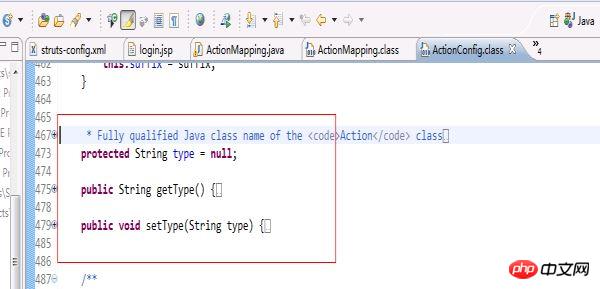Struts1 ActionMappingの例の説明
この記事では主に Struts1 チュートリアルの ActionMapping を紹介します。編集者はそれを参考として共有します。エディターに従って見てみましょう
まず、ブレークポイントは processpath メソッドの外にあります
今日は、ActionMapping を取得する方法を見ていきます。メソッド---プロセスマッピング。  その前に、ActionMapping について簡単に説明します。ソース コードから、最も重要な属性は、主に対応する Struts のパス、type、forwardMap に似ていることがわかります。 config 設定ファイル。これは、この設定ファイルの情報をメモリに保存します。
その前に、ActionMapping について簡単に説明します。ソース コードから、最も重要な属性は、主に対応する Struts のパス、type、forwardMap に似ていることがわかります。 config 設定ファイル。これは、この設定ファイルの情報をメモリに保存します。
特定の mvc small インスタンスの ActionMapping コードは次のとおりです:
package com.cjq.servlet;
import java.util.Map;
public class ActionMapping {
private String path;
private Object type;
private Map forwardMap;
public String getPath() {
return path;
}
public void setPath(String path) {
this.path = path;
}
public Object getType() {
return type;
}
public void setType(Object type) {
this.type = type;
}
public Map getForwardMap() {
return forwardMap;
}
public void setForwardMap(Map forwardMap) {
this.forwardMap = forwardMap;
}
}

 ActionMapping の内容についていくつか説明したので、ActionMapping についてはある程度理解できたと思います。それでは、システムはどのように ActionMapping を生成し、どのようにして ActionMapping を見つけるのでしょうか?これが今日話したいことのすべてです:
ActionMapping の内容についていくつか説明したので、ActionMapping についてはある程度理解できたと思います。それでは、システムはどのように ActionMapping を生成し、どのようにして ActionMapping を見つけるのでしょうか?これが今日話したいことのすべてです:
Web で

/**
* <p>Select the mapping used to process theselection path for this request
* If no mapping can be identified, createan error response and return
* <code>null</code>.</p>
*
* @param request The servlet request weare processing
* @param response The servlet response weare creating
* @param path The portion of the requestURI for selecting a mapping
*
* @exception IOException if an input/outputerror occurs
*/
protectedActionMapping processMapping(HttpServletRequestrequest,
HttpServletResponse response,
String path)
throws IOException {
// Is there a mapping for this path?
ActionMapping mapping = (ActionMapping)
moduleConfig.findActionConfig(path);
// If a mapping is found, put it in the request and return it
if (mapping != null) {
request.setAttribute(Globals.MAPPING_KEY, mapping);
return (mapping);
}
// Locate the mapping for unknown paths (if any)
ActionConfig configs[] = moduleConfig.findActionConfigs();
for (int i = 0; i < configs.length; i++) {
if (configs[i].getUnknown()) {
mapping = (ActionMapping)configs[i];
request.setAttribute(Globals.MAPPING_KEY, mapping);
return (mapping);
}
}
// No mapping can be found to process this request
String msg = getInternal().getMessage("processInvalid");
log.error(msg + " " + path);
response.sendError(HttpServletResponse.SC_NOT_FOUND, msg);
return null;
}ActionMapping mapping =(ActionMapping) moduleConfig.findActionConfig(path);
if (mapping != null) {
request.setAttribute(Globals.MAPPING_KEY, mapping);
return (mapping);
}
// Locate the mapping for unknownpaths (if any)
ActionConfig configs[] = moduleConfigfindActionConfigs();
for (int i = 0; i < configslength; i++) {
if (configs[i].getUnknown()) {
mapping = (ActionMapping)configs[i];
request.setAttribute(Globals.MAPPING_KEY, mapping);
return (mapping);
}
}
// No mapping can be found to process this request
String msg = getInternal().getMessage("processInvalid");
log.error(msg + " " + path);
response.sendError(HttpServletResponse.SC_NOT_FOUND, msg);
return null;/**
* <p>Retrieve and return the <code>ActionForm</code> associatedwith
* this mapping, creating and retaining oneif necessary. If there is no
* <code>ActionForm</code> associated with this mapping,return
* <code>null</code>.</p>
*
* @param request The servlet request weare processing
* @param response The servlet response weare creating
* @param mapping The mapping we are using
*/
protectedActionForm processActionForm(HttpServletRequestrequest,
HttpServletResponse response,
ActionMapping mapping) {
// Create (if necessary) a form bean to use
ActionForm instance = RequestUtilscreateActionForm
(request, mapping, moduleConfig, servlet);
if (instance == null) {
return (null);
}
// Store the new instance in the appropriate scope
if (log.isDebugEnabled()) {
log.debug(" Storing ActionForm bean instance in scope '" +
mapping.getScope() + "' under attribute key '" +
mapping.getAttribute() + "'");
}
if ("request".equals(mapping.getScope())) {
request.setAttribute(mapping.getAttribute(), instance);
} else {
HttpSession session =requestgetSession();
session.setAttribute(mapping.getAttribute(), instance);
}
return (instance);
}// Create (if necessary) a formbean to use
ActionForm instance = RequestUtils.createActionForm
(request, mapping, moduleConfig, servlet);
if (instance == null) {
return (null);
}publicstaticActionForm createActionForm(
HttpServletRequest request,
ActionMapping mapping,
ModuleConfig moduleConfig,
ActionServlet servlet) {
// Is there a form bean associated with this mapping?
String attribute = mappinggetAttribute();
if (attribute == null) {
return (null);
}
// Look up the form bean configuration information to use
String name = mapping.getName();
FormBeanConfig config =moduleConfigfindFormBeanConfig(name);
if (config == null) {
log.warn("No FormBeanConfig found under '"+ name + "'");
return (null);
}
ActionForm instance = lookupActionForm(request,attribute, mappinggetScope());
// Can we recycle the existing form bean instance (if there is one)?
try {
if (instance != null && canReuseActionForm(instance,config)) {
return (instance);
}
} catch(ClassNotFoundException e) {
log.error(servlet.getInternal().getMessage("formBean",config.getType()), e);
return (null);
}
return createActionForm(config,servlet);
}<form-beans>
<form-bean name="loginForm" type=".struts.LoginActionForm"/>
</form-beans>这个标签在服务器一启动的时候就会利用digester读取这里的配置信息,并且放在FormBeanConfig类中,这样我们可以通过上面那一句话就可以把LoginForm字符串生成相应的对象。
之后调用了ActionForm instance = lookupActionForm(request,attribute, mapping.getScope());这个方法,这个方法主要是查找scope属性中有没有存在ActionForm。具体实现:
if ("request".equals(scope)){
instance = (ActionForm)request.getAttribute(attribute);
} else {
session = request.getSession();
instance = (ActionForm)session.getAttribute(attribute);
}这里判断scope属性值是否为request,如果是则从request中读出ActionForm,如果不是则从session中读出。程序如果是第一次执行,那么ActionForm会是为空的。因为这里的ActionForm为空,所以就进入了if判断语句中,最后通过调用return createActionForm(config, servlet);创建ActionForm并且返回。
之后processActionForm就会把返回来的ActionForm放入request或者session中。具体实现就是:
if ("request".equals(mapping.getScope())){
request.setAttribute(mapping.getAttribute(), instance);
} else {
HttpSession session =request.getSession();
session.setAttribute(mapping.getAttribute(), instance);
}到此为止,ActionForm就创建完成,当ActionForm创建完成之后,就要用其他的方法来往ActionForm中赋值了
以上がStruts1 ActionMappingの例の説明の詳細内容です。詳細については、PHP 中国語 Web サイトの他の関連記事を参照してください。

ホットAIツール

Undresser.AI Undress
リアルなヌード写真を作成する AI 搭載アプリ

AI Clothes Remover
写真から衣服を削除するオンライン AI ツール。

Undress AI Tool
脱衣画像を無料で

Clothoff.io
AI衣類リムーバー

AI Hentai Generator
AIヘンタイを無料で生成します。

人気の記事

ホットツール

メモ帳++7.3.1
使いやすく無料のコードエディター

SublimeText3 中国語版
中国語版、とても使いやすい

ゼンドスタジオ 13.0.1
強力な PHP 統合開発環境

ドリームウィーバー CS6
ビジュアル Web 開発ツール

SublimeText3 Mac版
神レベルのコード編集ソフト(SublimeText3)

ホットトピック
 7563
7563
 15
15
 1385
1385
 52
52
 84
84
 11
11
 28
28
 99
99


